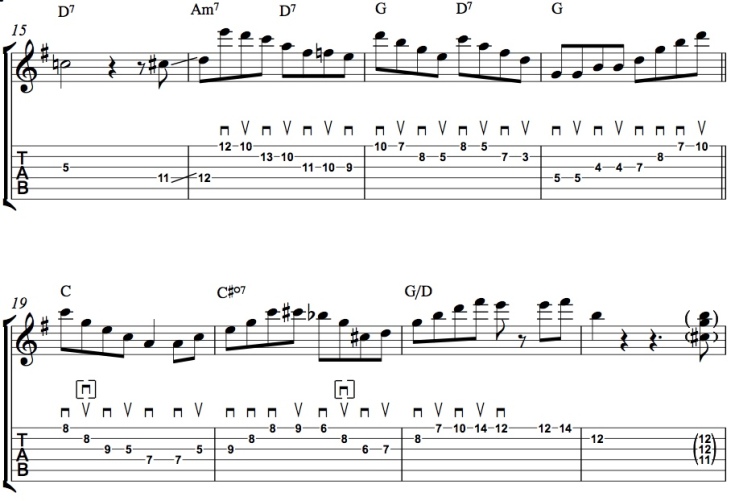Song: Oh, Lady Be Good (Gershwin)
Released/Recorded: 1937
Django Reinhardt (lead guitar); Joseph Reinhardt (rhythm guitar); Stephane Grappelli (violin); Louis Vola (bass)
Django recorded this Gershwin classic a few times in his career and from what I can find out, the one I’m looking at in this post is from a recording released in 1937. Django was a remarkable guitarist for many reasons: his virtuosity was matched only by his creativity; he was a groundbreaker, and his work with the Hot Club of France (1934-1948) gave birth to a whole genre – one that is still very much alive in the 21st century. This is a great solo for its own sake and that’s why I transcribed it, but I thought it would be interesting to add a bit of commentary. Here’s the original.
The solo as a whole features a lot of arpeggio work (something which is certainly key to the style) and Fig. 1 showcases Reinhardt’s ability to navigate the changes with long lines of connected arpeggios. He uses the arpeggios in a very linear fashion, ascending one and descending the next (bars 17-19) but a sense of melody is always present.

Bars 23-26 (fig 2) demonstrate a signature “Django-ism”. The tremolo chords are reminiscent of big band horn lines and could be an attempt at mimicking that sound. The triplet quarter note rhythms providing a forceful and angular juxtaposition to the constant “la pompe” of the rhythm section. The addition of the #5 and 9 of the chords adds to this angular sound*. The tremolo chords appear in many of Reinhardt’s improvisations and compositions and a notable/impressive example of this would be the opening of Mystery Pacific.
*the physical shpe of these chords would have been very natural for Reinhardt given the impairment of his 3rd and 4th fingers on his fretting hand. Reinhardt would often superimpose the same chord shape over different points of the underlying harmony. This can be seen in the last bar of fig 3: the shape is used to add alterations to the Ab7 underneith – in essense implying Ab13(#9), which then resolves to G. There’s a great article in the British Medical Journal (here) that explains more about this.

Figure 3 shows a visceral and idiomatic passage. Fretted notes are played in unison with open strings of the same pitch (in the same way that one might tune a guitar). This is an example of a specifically guitaristic improvisation – the aggressively played unison pitches resulting in a particular timbral effect. So he’s exploiting the quirks of the instrument for the sake of it, rather than emulating others or applying standard vocabulary.

In Figure 4 we can see a repeated rhythmic idea based on triplets and a bluesey string bend from C# up to D. Reinhardt likes this triplet idea and a very similar example can be found towards the end of I’ll See You In My Dreams [see approx. 02’19”-02’23”].

I hope this has been useful to you, there’s so much to talk about when it comes to Django’s playing (and Gypsy jazz in general). Technique is a big part of the sound, but something I didn’t want to get too caught up in with this post. You might have noticed that I’ve added picking directions in Figure 1 – these are my choices but I’ve also added bracketed directions that are consistent with Gypsy picking technique (though exactly what Django did, we’ll never know!). I’d strongly recommend a visit to www.djangobooks.com, Micheal Horowitz (the owner) has written some excellent books on Gypsy guitar playing – Gypsy Picking is an essential book for anybody learning the style. There are many other resources available there too, as well as a thriving online community.
Thank for reading, my full transcription is available by clicking here: Lady Be Good (Solo)
Leave a comment